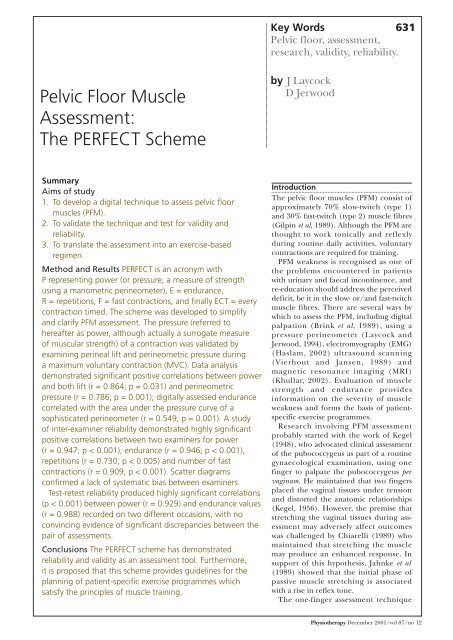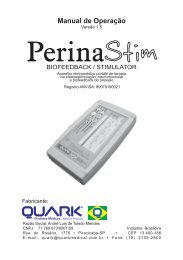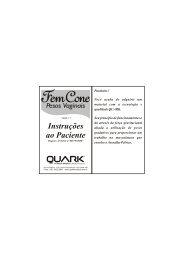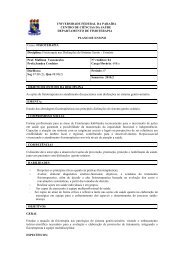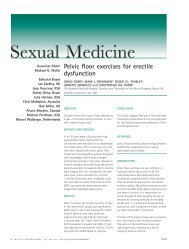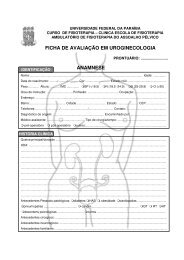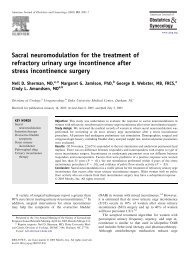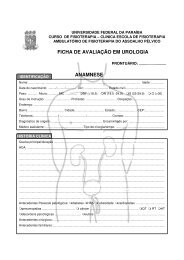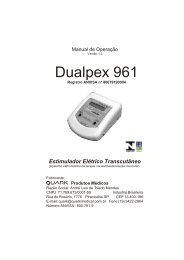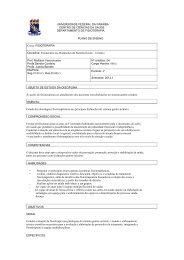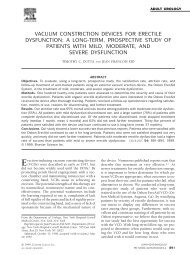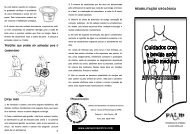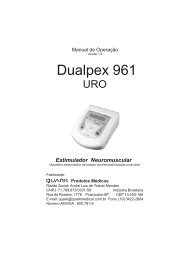Pelvic Floor Muscle Assessment: The PERFECT Scheme
Pelvic Floor Muscle Assessment: The PERFECT Scheme
Pelvic Floor Muscle Assessment: The PERFECT Scheme
Create successful ePaper yourself
Turn your PDF publications into a flip-book with our unique Google optimized e-Paper software.
Professional articles<br />
<strong>Pelvic</strong> <strong>Floor</strong> <strong>Muscle</strong><br />
<strong>Assessment</strong>:<br />
<strong>The</strong> <strong>PERFECT</strong> <strong>Scheme</strong><br />
Summary<br />
Aims of study<br />
1. To develop a digital technique to assess pelvic floor<br />
muscles (PFM).<br />
2. To validate the technique and test for validity and<br />
reliability.<br />
3. To translate the assessment into an exercise-based<br />
regimen.<br />
Method and Results <strong>PERFECT</strong> is an acronym with<br />
P representing power (or pressure, a measure of strength<br />
using a manometric perineometer), E = endurance,<br />
R = repetitions, F = fast contractions, and finally ECT = every<br />
contraction timed. <strong>The</strong> scheme was developed to simplify<br />
and clarify PFM assessment. <strong>The</strong> pressure (referred to<br />
hereafter as power, although actually a surrogate measure<br />
of muscular strength) of a contraction was validated by<br />
examining perineal lift and perineometric pressure during<br />
a maximum voluntary contraction (MVC). Data analysis<br />
demonstrated significant positive correlations between power<br />
and both lift (r = 0.864; p = 0.031) and perineometric<br />
pressure (r = 0.786; p = 0.001); digitally assessed endurance<br />
correlated with the area under the pressure curve of a<br />
sophisticated perineometer (r = 0.549; p = 0.001). A study<br />
of inter-examiner reliability demonstrated highly significant<br />
positive correlations between two examiners for power<br />
(r = 0.947; p < 0.001), endurance (r = 0.946; p < 0.001),<br />
repetitions (r = 0.730; p < 0.005) and number of fast<br />
contractions (r = 0.909; p < 0.001). Scatter diagrams<br />
confirmed a lack of systematic bias between examiners.<br />
Test-retest reliability produced highly significant correlations<br />
(p < 0.001) between power (r = 0.929) and endurance values<br />
(r = 0.988) recorded on two different occasions, with no<br />
convincing evidence of significant discrepancies between the<br />
pair of assessments.<br />
Conclusions <strong>The</strong> <strong>PERFECT</strong> scheme has demonstrated<br />
reliability and validity as an assessment tool. Furthermore,<br />
it is proposed that this scheme provides guidelines for the<br />
planning of patient-specific exercise programmes which<br />
satisfy the principles of muscle training.<br />
Key Words<br />
631<br />
<strong>Pelvic</strong> floor, assessment,<br />
research, validity, reliability.<br />
by J Laycock<br />
D Jerwood<br />
Introduction<br />
<strong>The</strong> pelvic floor muscles (PFM) consist of<br />
approximately 70% slow-twitch (type 1)<br />
and 30% fast-twitch (type 2) muscle fibres<br />
(Gilpin et al, 1989). Although the PFM are<br />
thought to work tonically and reflexly<br />
during routine daily activities, voluntary<br />
contractions are required for training.<br />
PFM weakness is recognised as one of<br />
the problems encountered in patients<br />
with urinary and faecal incontinence, and<br />
re-education should address the perceived<br />
deficit, be it in the slow- or/and fast-twitch<br />
muscle fibres. <strong>The</strong>re are several ways by<br />
which to assess the PFM, including digital<br />
palpation (Brink et al, 1989), using a<br />
pressure perineometer (Laycock and<br />
Jerwood, 1994), electromyography (EMG)<br />
(Haslam, 2002) ultrasound scanning<br />
(Vierhout and Jansen, 1989) and<br />
magnetic resonance imaging (MRI)<br />
(Khullar, 2002). Evaluation of muscle<br />
strength and endurance provides<br />
information on the severity of muscle<br />
weakness and forms the basis of patientspecific<br />
exercise programmes.<br />
Research involving PFM assessment<br />
probably started with the work of Kegel<br />
(1948), who advocated clinical assessment<br />
of the pubococcygeus as part of a routine<br />
gynaecological examination, using one<br />
finger to palpate the pubococcygeus per<br />
vaginam. He maintained that two fingers<br />
placed the vaginal tissues under tension<br />
and distorted the anatomic relationships<br />
(Kegel, 1956). However, the premise that<br />
stretching the vaginal tissues during assessment<br />
may adversely affect outcomes<br />
was challenged by Chiarelli (1989) who<br />
maintained that stretching the muscle<br />
may produce an enhanced response. In<br />
support of this hypothesis, Jahnke et al<br />
(1989) showed that the initial phase of<br />
passive muscle stretching is associated<br />
with a rise in reflex tone.<br />
<strong>The</strong> one-finger assessment technique<br />
Physiotherapy December 2001/vol 87/no 12
632<br />
Laycock, J and<br />
Jerwood, D (2001).<br />
‘<strong>Pelvic</strong> floor muscle<br />
assessment: <strong>The</strong><br />
<strong>PERFECT</strong> <strong>Scheme</strong>’,<br />
Physiotherapy, 87, 12,<br />
631-642.<br />
Physiotherapy December 2001/vol 87/no 12<br />
was again described by Hendrickson<br />
(1981), who defined a mild contraction<br />
as slight unsustained pressure on the<br />
examiner's finger; a moderate contraction<br />
as firm pressure held for one to three<br />
seconds; and a strong contraction as<br />
forceful pressure on the examiner's finger<br />
sustained for four seconds or more.<br />
A different method was devised by<br />
Graber et al (1981) based on four components:<br />
control, sustained strength,<br />
atrophy and tone. Control is measured<br />
using a perineometer and indicates the<br />
patient's ability to contract and relax the<br />
PFM to command. Sustained strength is<br />
an indication of the time (up to 10<br />
seconds) that a strong contraction could<br />
be held. Atrophy is used to describe the<br />
development and wastage of the muscle.<br />
This involved the technique of mapping,<br />
which necessitated palpating the PFM and<br />
charting areas of reduced muscle bulk.<br />
Tone was determined by the degree of<br />
resistance of the muscle against moderate<br />
pressure from the examining finger.<br />
A further report (Worth et al, 1986)<br />
described another one-finger digital<br />
vaginal assessment with four components:<br />
pressure, duration, ribbing and position<br />
(of the examining finger).<br />
■ <strong>The</strong>y defined pressure as the strength<br />
of contraction. If no pressure is felt, a<br />
score of 1 is given. If moderate pressure<br />
is felt, a score of 2 is given, and firm<br />
pressure is recorded as 3.<br />
■ Duration is based on the length of time<br />
a contraction can be sustained. If no<br />
contraction is felt or the contraction<br />
lasts no longer than 1 second, a score<br />
of 1 is assigned. A contraction held for<br />
2 to 3 seconds is scored 2, and a score<br />
of 3 is assigned to a contraction held<br />
for 4 or more seconds.<br />
■ An assessment of ribbing refers to the<br />
tone and texture of the PFM during<br />
a contraction. If the muscle feels soft<br />
and flabby, it is assigned a score of 1;<br />
a score of 2 describes a muscle that<br />
feels different from the surrounding<br />
tissues but not ribbed, and a score of<br />
3 is assigned if the muscle feels distinct,<br />
like rings of ribbing or ribbed muscle<br />
tissue.<br />
■ <strong>Assessment</strong> of position refers to the<br />
plane the examining finger is in,<br />
in relation to the vaginal introitus.<br />
If no force is exerted and the finger<br />
can easily slip out, a score of 1 is given.<br />
If the finger can be gripped somewhat<br />
but remains in the same position, a<br />
score of 2 is given, and if the finger is<br />
forcibly gripped, expelled, or pulled<br />
anteriorly, a score of 3 is given.<br />
Test-retest reliability of this scoring<br />
system showed a statistically significant<br />
relationship of observation between ten<br />
patients examined and then re-examined<br />
10 days later.<br />
Another scoring system, this time linked<br />
with incontinence, was described by Brink<br />
et al (1989). This measure uses concepts<br />
of pressure (rated 1 to 4), time and<br />
displacement. <strong>The</strong>se were evaluated by<br />
the index and middle fingers in the<br />
antero-posterior position (index finger<br />
resting on the middle finger) introduced<br />
4 cm to 6 cm into the vagina. Test-retest<br />
for this scoring method was r = 0.65,<br />
p < 0.01, with inter-rater reliability<br />
r = 0.91, p < 0.01. A negative correlation<br />
between muscle strength and both urine<br />
loss and age was demonstrated.<br />
<strong>The</strong> authors of all the aforementioned<br />
studies did not attempt to use any<br />
standard international muscle-grading<br />
scheme or to differentiate between<br />
slow- and fast-twitch muscle activity.<br />
Furthermore, they did not relate the<br />
assessment findings to an individual<br />
exercise programme. Moreover, cocontraction<br />
of the abdominal muscles<br />
was discouraged and this is now<br />
acknowledged to be inappropriate<br />
(Sapsford et al, 2001).<br />
Aims of Study<br />
1. To develop a digital technique for<br />
quantitative assessment of the<br />
voluntary contractility of the PFM.<br />
2. To validate the above technique and<br />
test for observer reliability.<br />
3. To translate the measurements from<br />
the digital assessment into the<br />
planning of a patient-specific exercise<br />
programme.<br />
Methods and Materials<br />
<strong>PERFECT</strong> is an acronym to remind all<br />
health professionals of the need to<br />
assess the main components of PFM<br />
contractility. This assessment scheme was<br />
developed to provide a simple, reliable<br />
method of PFM evaluation and involves<br />
four components, as shown in table 1.
Professional articles<br />
Table 1: <strong>The</strong> <strong>PERFECT</strong> assessment scheme<br />
P Power (pressure)<br />
E Endurance<br />
R Repetitions<br />
F Fast<br />
E Every<br />
C Contraction<br />
T Timed<br />
Although the study was carried out on<br />
women by palpating the perivaginal<br />
muscles per vaginam, the <strong>PERFECT</strong><br />
assessment can also be used for PFM<br />
assessment per rectum in men and women.<br />
To ensure reproducibility, the following<br />
factors were adopted throughout the<br />
study:<br />
■ <strong>The</strong> location and action of the pelvic<br />
floor muscles were described to the<br />
subjects in enough detail for adequate<br />
understanding of this muscle group.<br />
■ Whenever possible, subjects were<br />
positioned in supine with their head on<br />
two pillows. <strong>The</strong> hips were flexed and<br />
abducted, and the knees bent.<br />
■ <strong>The</strong> PFM were examined using the<br />
index finger placed approximately<br />
4 cm to 6 cm inside the vagina and<br />
positioned at 4 o'clock and 8 o'clock<br />
to monitor muscle activity. Moderate<br />
pressure was applied over the muscle<br />
bulk to assist in the initiation of the<br />
appropriate muscle contraction.<br />
■ Verbal informed consent was obtained<br />
from all subjects.<br />
Power<br />
Power is measured on a modified Oxford<br />
scale (table 2). <strong>The</strong> authors acknowledge<br />
that digital palpation during a maximal<br />
voluntary contraction (MVC) evaluates<br />
muscle strength, not power. However, with<br />
this caveat, the misnomer ‘power’ will be<br />
used throughout the text.<br />
<strong>The</strong> following definitions are proposed:<br />
Grade 0 No discernible muscle<br />
contraction.<br />
Grade 1 A flicker or pulsation is felt<br />
under the examiner's finger.<br />
Grade 2 An increase in tension is<br />
detected, without any discernible lift.<br />
Grade 3 <strong>Muscle</strong> tension is further<br />
enhanced and characterised by lifting of<br />
the muscle belly and also elevation of the<br />
posterior vaginal wall. A grade 3 and<br />
stronger can be observed as an in-drawing<br />
of the perineum and anus.<br />
Grade 4 Increased tension and a good<br />
contraction are present which are capable<br />
of elevating the posterior vaginal wall<br />
against resistance (digital pressure<br />
applied to the posterior vaginal wall).<br />
Grade 5 Strong resistance can be applied<br />
to the elevation of the posterior vaginal<br />
wall; the examining finger is squeezed<br />
and drawn into the vagina (like a hungry<br />
baby sucking a finger).<br />
Table 2: Proposed modified Oxford grading<br />
scheme<br />
Grading <strong>Muscle</strong> response<br />
0 Nil<br />
1 Flicker<br />
2 Weak<br />
3 Moderate<br />
4 Good<br />
5 Strong<br />
Consequently, in a specific case, the<br />
power could simply be recorded as<br />
grade 3 for a moderate contraction.<br />
However, the registered grade is<br />
permitted to be augmented with a symbol<br />
+ or –, when the need arises. Thus 3+<br />
could be translated as there being more<br />
than a moderate contraction but less than<br />
a good contraction (grade 4). Similarly, a<br />
3-- is recorded when the contraction is less<br />
than a grade 3, but more than a grade 2.<br />
This augmentation is to allow for an<br />
element of doubt to be introduced and<br />
thereby to soften this (partly subjective)<br />
six-point ordinal scale. <strong>The</strong>re will<br />
admittedly be a learning curve involved<br />
in assessing the strength of a PFM<br />
contraction.<br />
Endurance<br />
Endurance is expressed as the length of<br />
time, up to 10 seconds, that an MVC can<br />
be sustained before the strength is<br />
reduced by 35% or more. In other<br />
words, the contraction is timed until<br />
the muscle starts to fatigue. A further<br />
possible indication of PFM fatigue may<br />
be the simultaneous contraction of hip<br />
adductors and glutei, and the stronger cocontraction<br />
of transversus abdominis.<br />
Breath-holding should be discouraged; if<br />
detected, the subject should be instructed<br />
to contract the pelvic floor on expiration.<br />
633<br />
Authors<br />
J Laycock PhD FCSP<br />
is a specialist<br />
continence<br />
physiotherapist in<br />
private practice who<br />
carrried out the<br />
research for this<br />
article.<br />
D Jerwood BSc PhD<br />
FSS is head of<br />
mathematics, School<br />
of Computing and<br />
Mathematics,<br />
University of<br />
Bradford, and was<br />
responsible for the<br />
statistics.<br />
This article was<br />
received on January<br />
17, 2000, and<br />
accepted on August<br />
22, 2001.<br />
Address for<br />
Correspondence<br />
Jo Laycock,<br />
<strong>The</strong> Culgaith Clinic,<br />
Pea Top Grange,<br />
Culgaith, Penrith<br />
CA10 1QW.<br />
Physiotherapy December 2001/vol 87/no 12
634<br />
Physiotherapy December 2001/vol 87/no 12<br />
Example 1: 3/5 = grade 3 held for 5 seconds<br />
Repetitions<br />
<strong>The</strong> number of repetitions (up to 10) of<br />
the specific MVC (eg 3 as in example 1) is<br />
recorded, allowing four seconds rest<br />
between each contraction (which lasts<br />
for 5 seconds in example 1). <strong>The</strong> purpose<br />
of the <strong>PERFECT</strong> assessment is to<br />
determine the number of contractions<br />
necessary to overload the muscle, develop<br />
a practicable exercise programme and so<br />
produce a training effect.<br />
Different ‘rest’ periods have been<br />
tested, and in the experience of the<br />
authors, four seconds will allow weak,<br />
easily fatigued muscles time to recover<br />
without permitting excessive rest periods<br />
for stronger muscles. It would be impractical<br />
to permit, say, 20 seconds rest<br />
between each contraction, as this would<br />
make the exercise session too long, and<br />
might never overload the PFM in some<br />
cases. Furthermore, in practical terms,<br />
once a subject can perform 10 repetitions<br />
of a 10-second maximum contraction, the<br />
rest time is reduced.<br />
Limiting both repetitions and endurance<br />
to a maximum in this way is<br />
formally referred to as right-censoring of<br />
data, and its impact on results will be<br />
discussed later.<br />
Example 2: 2/3/6 = grade 2 held for<br />
3 seconds, and repeated 6 times (with<br />
4 seconds rest between each contraction)<br />
Fast<br />
After a short rest (at least one minute),<br />
the number (up to 10) of one-second<br />
MVCs is assessed. Subjects are instructed<br />
to ‘contract-relax’ as quickly and strongly<br />
as possible, in their own time, until the<br />
muscles fatigue. Many patients can<br />
perform more than 10 fast contractions,<br />
but for practical reasons, the assessment<br />
stage should be limited to 10. Subsequent<br />
assessment during a treatment programme<br />
may identify a greater number<br />
of fast contractions, and that should be<br />
the number practised by those patients<br />
on a daily basis.<br />
Example 3: 4/6/5//9 = good contraction,<br />
held for 6 seconds, repeated 5 times,<br />
followed by 9 fast contractions<br />
Every Contraction Timed<br />
This completes the acronym and reminds<br />
the examiner to time and record the<br />
above sequence of events.<br />
Validity Study 1<br />
Since an increase in pressure on the<br />
examiner's finger may be misinterpreted<br />
as pressure exerted by an increase in<br />
intra-abdominal pressure (rather than by<br />
perivaginal muscle contraction), it was<br />
necessary to validate the source of activity.<br />
It is well documented (Bø et al, 1989) that<br />
a moderate to strong PFM contraction<br />
also incorporates an element of lift which<br />
would not be manifest during an increase<br />
in abdominal pressure alone. Validation<br />
of the PFM contraction was therefore<br />
ratified by measuring perineal lift.<br />
Eight women, mean age 43.9 years<br />
(range 21 to 61 years) and mean parity<br />
2.5 (range 0 to 5), randomly recruited<br />
from a gynaecology outpatient clinic,<br />
agreed to take part in this study. A lightweight<br />
vaginal probe with a thin plastic<br />
rod extension was introduced into the<br />
distal 5 cm of the vagina. <strong>The</strong> rod was<br />
placed alongside a ruler and cephalad<br />
movement of the rod during an MVC was<br />
observed and measured.<br />
Validity Study 2<br />
A consecutive sample of 233 women<br />
attending a gynaecology outpatient<br />
clinic were recruited into this study, of<br />
whom 147 were diagnosed as having stress<br />
incontinence. Power and endurance were<br />
assessed both digitally (as described<br />
above) and, after a two-minute rest, using<br />
a sophisticated pressure perineometer<br />
previously tested for reproducibility and<br />
reliability (Laycock and Jerwood, 1994).<br />
This perineometer recorded maximum<br />
pressure and endurance was assessed by<br />
calculating the area under the pressure<br />
curve of a maximum 10-second contraction.<br />
<strong>The</strong> same patient position (see<br />
above) was used for each method.<br />
Inter-examiner Reliability Study<br />
Ten patients were independently assessed<br />
by two examiners at the same visit.<br />
Demographically, all the women were<br />
incontinent, mean age 47.6 years (range<br />
26 to 58), and mean parity 2.7 (range 1 to<br />
4). Each subject was tested for strength<br />
(scale 0 to 5), endurance (up to 10 seconds),<br />
number of repetitions (up to 10)<br />
and number of fast contractions (up to<br />
10), with at least two minutes rest between<br />
each test and three minutes rest between<br />
each examination. <strong>The</strong> order of examination<br />
between physiotherapists was<br />
randomised in order to eliminate
Professional articles<br />
systematic bias. Inter-examiner reliability<br />
over the two assessments was determined<br />
using correlation and graphical techniques.<br />
Each examiner recorded the<br />
values of the assessment independently,<br />
without knowledge of the other's result.<br />
Test-retest Reliability<br />
Twenty incontinent women entered this<br />
study. <strong>Assessment</strong> was carried out before<br />
cystometry and repeated at the first<br />
physiotherapy appointment two to<br />
five weeks later by the same examiner,<br />
evaluating power and endurance. To<br />
conduct this test responsibly, the results of<br />
the first assessment were not available<br />
until after completion of the second<br />
examination. Test-retest reliability was<br />
determined using correlation and graphical<br />
techniques for the two results.<br />
Exercise Programme Planning<br />
<strong>The</strong> third purpose of the study was to<br />
formulate a method for translating the<br />
<strong>PERFECT</strong> assessment into a patientspecific<br />
exercise programme. Not only<br />
has such a regimen to satisfy general<br />
muscle training principles of overload<br />
and specificity, but it must also be practicable<br />
within the context of the individual<br />
patient since, without a high degree of<br />
compliance, the therapy is unlikely to be<br />
effective.<br />
Patient 1<br />
P E R F<br />
3 5 4 7 This assessment describes a<br />
patient with a moderate<br />
(grade 3) contraction, held<br />
for 5 seconds and repeated<br />
4 times; followed by 7 fast<br />
contractions<br />
This patient would be instructed<br />
to practise 4 (R) of her strongest<br />
contractions lasting 5 seconds (E) (with 4<br />
seconds rest between) at each exercise<br />
session, and 7 fast (F) strong contractions<br />
at other times. She should aim to increase<br />
the number of repetitions of the long<br />
MVC over subsequent weeks up to 10<br />
repetitions. After this, over the succeeding<br />
weeks, she should aim to increase the<br />
hold time to 10 seconds. In addition, the<br />
number of fast contractions should be<br />
progressively increased to the maximum<br />
number possible (many patients can do<br />
up to 50 fast contractions). <strong>The</strong> aim is<br />
to be able to perform 10 repetitions of<br />
a 10-second MVC at regular intervals<br />
during the day, and 10+ fast contractions<br />
at other times during the day. Equal<br />
numbers of sessions of slow and fast contractions<br />
are encouraged, up to six per<br />
day.<br />
Patient 2<br />
P E R F<br />
2 2 3 – This assessment describes<br />
a patient with a weak<br />
(grade 2) contraction,<br />
held for 2 seconds and<br />
repeated 3 times<br />
This patient needs to practise 3 (R) of<br />
her strongest contractions lasting 2 seconds<br />
(E) (with 4 seconds rest between<br />
each contraction) as many times as<br />
possible during the day. In view of the<br />
weak state of the PFM, assessing the<br />
number of fast contractions would be<br />
confusing, and this should be done at a<br />
later date when endurance has improved<br />
to 4 seconds. Treatment should progress<br />
in the first instance by aiming to hold the<br />
contraction for 3 (then 4) seconds. Once<br />
this is achieved, strength should be<br />
addressed and the patient encouraged<br />
to contract harder. Once a grade 3 has<br />
been achieved, endurance is once again<br />
addressed, and the subject encouraged<br />
to increase the length of contraction.<br />
In all cases, regular PFM re-assessment<br />
is required to monitor progress and<br />
establish a ‘new’ exercise programme.<br />
Results<br />
Validity Study 1<br />
This study measured perineal lift (in<br />
centimetres) during an MVC (P – scale<br />
0 to 5) and the results are displayed in<br />
table 3. Six of the eight subjects examined<br />
during an MVC exhibited cephalad<br />
movement of the vaginal probe greater<br />
Table 3: Results of study to measure perineal lift<br />
Subject Age Parity P Continence status Lift (cm)<br />
(years)<br />
1 61 2 2+ Incontinent 0.3<br />
2 51 3 2+ Incontinent 0.4<br />
3 21 0 3+ Continent 0.5<br />
4 36 2 5 Continent 0.7<br />
5 53 4 2 Incontinent 0.0<br />
6 45 2 3+ Incontinent 1.0<br />
7 51 5 2+ Incontinent 0.1<br />
8 31 2 4 Incontinent 0.7<br />
635<br />
Physiotherapy December 2001/vol 87/no 12
636<br />
Physiotherapy December 2001/vol 87/no 12<br />
than 0.1 cm. <strong>The</strong> subjects who failed to<br />
demonstrate such a movement (patients 5<br />
and 7, both incontinent) had had<br />
delivered per vaginam four and five babies<br />
respectively, compared with a mean of 1.8<br />
babies for the remaining subjects. Over all<br />
subjects, a degree of negative correlation<br />
between perineal lift and parity<br />
was detected (r = –0.664; p = 0.073)<br />
(Spearman's rho for ordinal data).<br />
Any correlation coefficient in the range<br />
0.61 to 0.80 can be considered ‘good’,<br />
and with r = –0.664 the coefficient of<br />
variation is 44% (100 ρ 2 ). In other words,<br />
44% of the variation in perineal lift can<br />
be explained by parity alone. It should be<br />
noted in passing that this evidence has<br />
been detected in a sample of only eight<br />
patients and therefore fails to reach levels<br />
at which statistical significance can be<br />
claimed, although the result may still be<br />
clinically significant. More pertinent is<br />
that examination of the data for all eight<br />
subjects showed a positive value for<br />
Spearman's coefficient of correlation<br />
between P (modified Oxford grading,<br />
scale 0 to 5) and perineal lift (r = 0.864;<br />
p = 0.031). This coefficient is in excess<br />
of 0.80 and therefore can be considered<br />
‘very good’, however once again this<br />
result must be viewed in the context of<br />
sample size (n = 8). <strong>The</strong> coefficient of<br />
variation now rises to almost 75% and<br />
confirms the sympathetic relationship<br />
between perineal lift and the digital<br />
assessment scale discussed earlier. This<br />
adds some credence to the hypothesis<br />
that digital assessment can be used to<br />
measure power (P) of a pelvic floor<br />
muscle contraction.<br />
Table 4: Results of Validity Study 2. Demographic variables of age,<br />
parity and BMI<br />
Variable Continent Incontinent Difference<br />
(n = 86) (n = 147)<br />
No (SD) No (SD)<br />
Age 38.5 (16.8) 45.4 (11.9) p < 0.00005<br />
Parity 1.5 (1.4) 2.5 (1.5) p < 0.00005<br />
BMI 23.3 (3.1) 25.9 (4.0) p < 0.00005<br />
P 3.6 (1.1) 3.1 (1.2) p < 0.00005<br />
Max. press. 52 (24) 32 (21) p < 0.00005<br />
E 7.0 (2.9) 6.3 (3.3) p = 0.103<br />
Area 346 (198) 216 (156) p < 0.00005<br />
SD = standard deviation<br />
P = power (scale 0 to 5) digital assessment<br />
Maximum pressure (mm Hg) perineometric assessment<br />
E = endurance (seconds) digital assessment<br />
Area (mm Hg.s) measured with perineometer<br />
Validity Study 2<br />
<strong>The</strong> results of the digital and perineometric<br />
testing are shown in table 4<br />
together with a selected number of<br />
demographic details. It is now relevant<br />
to note the large number of subjects<br />
in each group (86 continent and 147<br />
incontinent), so that statistical comparisons<br />
between groups are not so sensitive<br />
to choice of test procedure (parametric or<br />
non-parametric).<br />
Appealing to the central limit theorem<br />
for induced asymptotic normality, it<br />
becomes reasonable to apply t-tests for<br />
unrelated samples for all inter-group<br />
comparisons. <strong>The</strong> incontinent subjects<br />
were found to be older on average (by 6.9<br />
years), had borne one more child on<br />
average, and were associated with a higher<br />
BMI (by 2.6 units on average). All these<br />
differences were found to be statistically<br />
significant with p < 0.00005. It should be<br />
said that large sample sizes generally<br />
produce much reduced standard errors<br />
for the differences in means, and statistical<br />
power rises accordingly. In these cases,<br />
statistical significance is often easier to<br />
demonstrate.<br />
From a clinical point of view, on average,<br />
the continent subjects exhibited<br />
16% more power (digitally assessed), and<br />
63% higher maximum pressure, and<br />
generated 60% more area under the<br />
perineometric pressure curve. Each of<br />
these differences proved statistically<br />
significant (with p < 0.00005). Only<br />
endurance (also assessed by digital<br />
palpitation), which registered an average<br />
increase of 11% (of continent subjects<br />
over incontinents) failed to reach levels of<br />
statistical significance (p = 0.103).<br />
<strong>The</strong> relationship between the digital<br />
assessment of pressure (P) and the<br />
maximum perineometric pressure (r =<br />
0.786) implies that 62% of the variation in<br />
perineometric pressure could be<br />
explained by the variation in P. <strong>The</strong><br />
relationship between area under the<br />
pressure curve and endurance (E) was<br />
less convincing (r = 0.549), whereby only<br />
30% of the variation in area could be<br />
explained by the variation in E.<br />
Agreement between digital and<br />
perineometric measurements of pressure<br />
adds further evidence of the validity of<br />
this form of assessment for pelvic floor<br />
muscles.
Professional articles<br />
Inter-examiner Reliability Study<br />
Reliability between different examiners<br />
involved two physiotherapists (JL<br />
and SHD) each performing complete<br />
<strong>PERFECT</strong> assessments on ten subjects<br />
on the same visit, and the results are<br />
shown in table 5. Analysis shows highly<br />
significant positive correlation coefficients<br />
between the two examiners for P<br />
(r = 0.947; p < 0.001), E (r = 0.946;<br />
p < 0.001), R (r = 0.730; p < 0.005) and F<br />
(r = 0.909; p < 0.001).<br />
When testing for significance of<br />
correlation coefficients, the P values<br />
relate to rejection of a null hypothesis<br />
claiming that the true correlation is zero<br />
which is not a useful concept within<br />
validity studies. Subjects (such as patients<br />
3 and 4 in table 5) who are performing at<br />
the boundary of data censorship (that is,<br />
holding an MVC for at least 10 seconds,<br />
and being able to produce at least 10<br />
fast contractions) will enhance any<br />
correlation coefficients. Removing patients<br />
3 and 4 from these correlation<br />
studies will reduce every one of the<br />
coefficients given in table 5, the greatest<br />
impact being on R, for which the<br />
coefficient falls dramatically from r =<br />
0.730 to r = 0.530.<br />
Especially when assessing agreement<br />
between two examiners, it should be<br />
appreciated that a high coefficient of<br />
correlation is certainly necessary, but not<br />
(in itself) sufficient. Correlation is a<br />
concept which describes only linearity<br />
between variables – not agreement. It is<br />
therefore perfectly feasible for one<br />
assessor to display a systematic bias<br />
(compared with another assessor) with<br />
such consistency, that the results are still<br />
highly correlated. For ‘agreement’,<br />
further supportive evidence is required<br />
(Bland and Altman, 1999). This can be<br />
provided using a number of techniques,<br />
but perhaps the simplest is the scatter<br />
diagram (see figures 1 and 2). <strong>The</strong> digital<br />
assessment of pressure (P) of figure 1<br />
shows six agreements, three over-assessments<br />
(by SHD compared to JL) by<br />
only a half unit of grading, and only one<br />
(full unit) under-assessment. In nett<br />
terms, the mean difference over ten<br />
subjects is 0.05 which, when considered<br />
together with a correlation coefficient of<br />
r = 0.947, suggests a lack of systematic<br />
bias and a strong (linear) relationship<br />
between assessors.<br />
Similar plots result from the two<br />
Table 5: Analysis of results of digital assessment of ten patients<br />
by two examiners (SHD and JL) on the same visit<br />
Patient P E R F<br />
SHD JL SHD JL SHD JL SHD JL<br />
1 3.0 2.5 7 6 6 5 7 6<br />
2 4.0 4.0 9 10 3 6 8 7<br />
3 5.0 5.0 10 10 8 6 10 10<br />
4 4.5 4.0 10 10 8 7 10 10<br />
5 2.0 2.0 4 3 3 2 6 5<br />
6 2.0 3.0 3 2 4 5 5 6<br />
7 3.0 3.0 3 3 6 5 5 6<br />
8 1.0 1.0 2 2 1 2 3 2<br />
9 1.5 1.0 4 5 3 3 4 5<br />
10 4.0 4.0 3 3 4 5 7 7<br />
Spearman's<br />
correlation<br />
Coefficient<br />
r = 0.947 r = 0.946 r = 0.730 r = 0.909<br />
significance<br />
level<br />
p < 0.001 p < 0.001 p < 0.005 p < 0.001<br />
Repetitions (SHD)<br />
5<br />
4<br />
3<br />
2<br />
1<br />
0<br />
0<br />
1 2<br />
3 4 5<br />
Repetitions (JL)<br />
Fig 1: Pressure of PFM contractions assessed by JL and SHD with<br />
line of equality<br />
Repetitions (SHD)<br />
10<br />
8<br />
6<br />
4<br />
2<br />
0<br />
0<br />
2 4<br />
6 8 10<br />
Repetitions (JL)<br />
Fig 2: Numbers of repetitions recorded by JL and SHD with line<br />
of equality<br />
637<br />
Physiotherapy December 2001/vol 87/no 12
638<br />
Physiotherapy December 2001/vol 87/no 12<br />
assessments of endurance (E) and the two<br />
counts of fast contractions (F) (not<br />
reproduced here), however the weakest<br />
inter-assessor agreement was found with<br />
repetitions (R) and this is illustrated in<br />
figure 2. Now, there is only one (perfect)<br />
agreement, with four over-assessments<br />
(totalling 5 units) and three underassessments<br />
(also totalling 5 units); the<br />
greatest discrepancies occurr with two<br />
subjects who recorded 6 repetitions for<br />
JL. <strong>The</strong> mean nett difference is now zero<br />
but (with a correlation coefficient of only<br />
0.730), the impression is given of a lack of<br />
systematic bias between examiners with<br />
less convincing consistency. Notice,<br />
however, when recording repetitions the<br />
censoring limit of 10 which had been<br />
imposed by the physiotherapist was never<br />
actually attained for any of these ten<br />
subjects, although other imposed maxima<br />
were regularly attained by subjects 3 and 4.<br />
This could imply that the R component<br />
was found to be a particularly fatiguing<br />
exercise by those subjects, and its<br />
implementation introduced additional<br />
sources of intra-patient variation to be<br />
confounded with inter-assessor variation.<br />
<strong>The</strong> inter-examiner assessments of<br />
number of repetitions (R) apart, taken<br />
over the remaining three digital scores,<br />
this study demonstrated 46.7% exact<br />
agreement of the digital scores. However,<br />
disagreement in all but two cases (both in<br />
the repetition test) did not exceed one<br />
unit of measurement. <strong>The</strong>se encouraging<br />
results provide global evidence in support<br />
of the inter-examiner reliability of these<br />
components of the digital assessment of<br />
the PFM.<br />
Test-retest Reliability Study<br />
<strong>The</strong> results of re-testing 20 women two to<br />
five weeks after the initial assessment<br />
are shown in table 6. <strong>The</strong>se results show<br />
that for muscle strength (P), 45% exact<br />
agreement was demonstrated. Furthermore,<br />
of the 11 measures that differed,<br />
ten of these differed by only 0.5 grade and<br />
the remainder by one grade. In addition,<br />
it is shown that 8/11 demonstrated an<br />
increase in strength whereas 3/11<br />
demonstrated a decrease.<br />
Scatter graphs (similar to figures 1 and 2,<br />
but not reproduced here) illustrate a<br />
slight tendency for some patients to<br />
improve over the period between the<br />
tests. However, the mean nett shift of only<br />
+0.125 per patient is well within the<br />
Table 6: Test-retest results of digital assessment<br />
of power (P) and endurance (E)<br />
Patient Power Endurance<br />
Test 1 Test 2 Test 1 Test 2<br />
1 3.0 4.0 2 2<br />
2 0.0 0.0 0 0<br />
3 3.0 3.0 3 3<br />
4 4.0 3.5 10 10<br />
5 3.0 3.5 5 6<br />
6 3.5 4.0 10 10<br />
7 2.5 2.0 5 6<br />
8 2.0 2.0 2 3<br />
9 0.0 0.0 0 0<br />
10 3.0 3.5 7 7<br />
11 2.5 2.5 4 4<br />
12 2.5 3.0 2 3<br />
13 4.0 4.5 8 9<br />
14 4.0 4.0 10 10<br />
15 4.5 4.0 4 6<br />
16 2.5 2.5 8 8<br />
17 2.0 2.0 10 10<br />
18 3.0 3.5 10 10<br />
19 5.0 5.0 5 5<br />
20 3.5 4.0 10 10<br />
Spearman's<br />
correlation<br />
r = 0.929 r = 0.988<br />
Coefficient<br />
significance<br />
level<br />
p < 0.001 p < 0.001<br />
minimum unit of graduation (of 0.5).<br />
Regarding endurance, 70% exact<br />
agreement was demonstrated, with a<br />
variation of only one second in all except<br />
one, which was two seconds. In all cases,<br />
endurance remained the same or<br />
increased, despite the fact that these<br />
women were not instructed to practise<br />
pelvic floor exercises. <strong>The</strong> complete<br />
absence of patients with shorter<br />
endurance periods is surprising, but the<br />
mean nett shift is only 0.4 seconds per<br />
patient and (again) well within the<br />
minimum unit of evaluation (of one<br />
second).<br />
Evaluating Spearman's rank correlation<br />
coefficients for these test-retest results,<br />
the coefficient for power (P) is found to<br />
be 0.929 (p < 0.001) and for endurance<br />
(E) stands even higher at 0.988. <strong>The</strong>se<br />
extremely high levels of correlation<br />
together with mean discrepancies which<br />
cannot be reduced by systematic adjustments<br />
provide convincing evidence that,<br />
for an experienced physiotherapist, the<br />
digital evaluation of power and<br />
endurance of PFM contractions following<br />
a short delay is a reliable technique.
Professional articles<br />
Planning Exercise Programmes<br />
<strong>The</strong> procedure for planning patientspecific<br />
exercise programmes described<br />
earlier follows recognised muscle training<br />
methods and has proved to be successful<br />
in clinical practice. However, in the past,<br />
many women have admitted to neglecting<br />
to practise their prescribed pelvic floor<br />
exercises and so realistic regimens need<br />
to be agreed with each patient. Previously,<br />
the majority of patients have complained<br />
that pelvic floor exercises were not interesting,<br />
but with the introduction of long,<br />
and fast and short contractions, and the<br />
setting of targets, more women are cooperating<br />
in this self-help rehabilitation.<br />
Although data have not been made<br />
available here, a number of interesting<br />
facts have emerged as a result of this<br />
methodology. For example, a woman's<br />
ability to contract the PFM appears to be<br />
subject to a learning curve, and many<br />
women can begin to produce a stronger<br />
and longer contraction before any<br />
possible physiological change in the<br />
muscle fibres could have taken place.<br />
In addition, some women report an<br />
improvement in continence symptoms<br />
without any measurable improvement in<br />
their PFM contractility. This was discussed<br />
in a study by Miller et al (1996) who<br />
described ‘the knack’, a precisely-timed<br />
anticipatory pelvic floor contraction<br />
before and during a cough. Using<br />
‘the knack’, significant reduction in<br />
involuntary urine loss during a cough<br />
was demonstrated.<br />
Conclusions and Discussion<br />
In physiotherapy practice, palpation of a<br />
muscle can detect changes in resting<br />
tone, identify areas of atrophy and<br />
differentiate between the state of<br />
contraction and relaxation, and this is<br />
certainly the case with the pelvic floor<br />
muscles. During a vaginal examination<br />
using the distal pad of the index finger to<br />
palpate the perivaginal muscles, a definite<br />
bulging and lifting of the muscles are felt<br />
during a contraction, and in both the<br />
contracted and relaxed state, areas of<br />
atrophy can be detected.<br />
Furthermore, a moderate to strong<br />
contraction of the levator ani muscles has<br />
both a squeeze and a lift component, and<br />
the proposed digital assessment scoring<br />
system provides a means of calibrating<br />
this physical effect.<br />
<strong>The</strong> <strong>PERFECT</strong> assessment scheme,<br />
although a subjective method, has been<br />
shown to be reliable and reproducible.<br />
<strong>The</strong> first component P (power/pressure,<br />
but actually evaluating strength) graded<br />
the pressure exerted on the finger<br />
from 0 to 5, with intermediate scoring<br />
permitted (for example 3+), giving a<br />
greater flexibility than the scoring of<br />
1 to 4 suggested by Brink et al (1989).<br />
<strong>The</strong> Oxford grading system is well understood<br />
in physical medicine and the<br />
modifications described herein have<br />
proved to be an effective way of assessing<br />
PFM strength. Regarding different muscle<br />
components (that is, fast- and slow-twitch<br />
fibres), it has been shown that fast<br />
fibres are recruited only during activities<br />
involving speed and/or power (Edwards,<br />
1978) and if the response to a command<br />
to contract the PFM maximally is sluggish,<br />
then it is probable that only slow-twitch<br />
muscle fibres are being used. Jones and<br />
Rutherford (1987) reported that in some<br />
untrained muscles, the fast-firing muscle<br />
fibres are never recruited, and so these<br />
may need targeting in some other way<br />
during PFM rehabilitation. It is postulated<br />
that an MVC will recruit both fast-<br />
and slow-twitch muscle fibres (if the<br />
contraction is strong and brisk) and so<br />
P would represent recruitment of both<br />
fibre types.<br />
It is further hypothesised that the<br />
endurance (E) and repetitions (R) of a<br />
PFM contraction are measures of slowtwitch<br />
muscle fibre activity. Gosling et al<br />
(1981) described the PFM slow-twitch<br />
fibres as being responsible for maintaining<br />
continuous muscle activity over<br />
prolonged periods, with the fast-twitch<br />
fibres recruited reflexly during sudden<br />
increases in intra-abdominal pressure, for<br />
example when coughing. A reduction in<br />
slow-twitch activity would therefore<br />
manifest itself in a short duration<br />
contraction and few repetitions, and PFM<br />
in this category may thus be responsible<br />
for decreased support of the proximal<br />
urethra and reduced urethral occlusion.<br />
A reduction in fast-twitch fibre activity<br />
may result in a slower, weaker reflex<br />
response to increases in intra-abdominal<br />
pressure. Logically, one should assess both<br />
the fast- and slow-twitch muscle fibre<br />
activity before planning an exercise<br />
regimen.<br />
<strong>The</strong> third component in the <strong>PERFECT</strong><br />
assessment method, the number of<br />
repetitions a subject could perform<br />
639<br />
Physiotherapy December 2001/vol 87/no 12
640<br />
Physiotherapy December 2001/vol 87/no 12<br />
before the muscles fatigued, was incorporated<br />
into the scheme to provide<br />
information on the number of contractions<br />
an individual should perform<br />
at each exercise session to predict<br />
‘overload’. Previous studies have suggested<br />
a wide range of daily contractions;<br />
Benvenuti et al (1987) proposed 120 daily<br />
PFM contractions whereas Bø et al (1989)<br />
used 8 to 12 daily contractions, and these<br />
recommendations appeared to be made<br />
at random. <strong>The</strong> present study proposes<br />
patient-specific exercise programmes, as<br />
practised in other physiotherapy regimens<br />
for muscle dysfunction. <strong>The</strong> number of<br />
repetitions gives further information on<br />
fatigue; Edwards (1978) states that fatigue<br />
is failure to maintain the expected force<br />
with continued or repeated contractions.<br />
It is postulated that the last component,<br />
F -- number of fast contractions, provides<br />
a measure of fast-fibre activity. Millard<br />
(1987) was possibly the first to recognise<br />
the importance of practising fast and slow<br />
PFM contractions.<br />
Compared with other studies (Hendrickson,<br />
1981; Graber et al, 1981; Worth et<br />
al, 1986; Brink et al, 1989), the <strong>PERFECT</strong><br />
method gives the examiner more flexibility<br />
and is less ambiguous.<br />
Validity Study 1<br />
PFM digital assessment of strength is<br />
represented by P (power/pressure),<br />
which is thought to manifest itself<br />
with both squeeze pressure and lift.<br />
Consequently, it was decided to examine<br />
the ‘lift’ component of an MVC in this<br />
study. <strong>The</strong> sample number is small (n = 8)<br />
and so the results should be interpreted<br />
with caution, but analysis of the data<br />
showed a positive and significant<br />
correlation between perineal lift and<br />
digital assessment scores (r = 0.864). This<br />
theory would endorse the postural<br />
function of the PFM in supporting the<br />
proximal urethra, with reduced support,<br />
causing bladder neck descent on<br />
coughing, precipitating incontinence. It is<br />
postulated that continuous activity<br />
(resting tone) of the slow-twitch fibres<br />
should maintain the advantageous<br />
position of the bladder neck and<br />
proximal urethra, with the fast-twitch<br />
fibres reflexly recruited to provide a<br />
quick, strong re-enforcement of urethral<br />
lift and squeeze, during, for example,<br />
coughing. Bladder neck lift was also<br />
reported by Vierhout and Jansen (1989)<br />
using transrectal ultrasound on 17 women<br />
(15 with stress incontinence and two<br />
with other bladder problems). <strong>The</strong>y reported<br />
a mean lift of 5.5 mm with a PFM<br />
contraction which compares well with<br />
the 5.0 mm lift observed in incontinent<br />
women in this study (6.0 mm for continent<br />
subjects).<br />
Validity Study 2<br />
This study aimed to validate the subjective<br />
digital assessment of P (pressure/power)<br />
and E (endurance) and to compare<br />
the sensitivity between digital and<br />
perineometric techniques in a large<br />
sample of women (n = 233), most of<br />
whom were incontinent.<br />
Accuracy of the digital method was<br />
demonstrated by the highly significant<br />
correlation of P with maximum pressure<br />
(r = 0.786; p < 0.001), and E with the area<br />
under the pressure curve (r = 0.549;<br />
p < 0.001) as recorded by a perineometer.<br />
This evidence lends support to the<br />
validity of the digital method. <strong>The</strong>se<br />
findings are reinforced by the study by<br />
Brink et al (1989) of 388 older women<br />
(mean age 67.5), who showed significant<br />
positive correlation between digital<br />
pressure scores and electromyography<br />
(EMG) scores (r = 0.60; p < 0.01).<br />
Further support for the digital technique<br />
is given in a study (N = 263)<br />
comparing digital scores (modified<br />
Oxford scale) and pressure (using the<br />
pelvic floor exerciser/perineometer –<br />
PFX), where good agreement between<br />
the two techniques was demonstrated<br />
(Isherwood and Rane, 2000).<br />
To assess endurance digitally the<br />
examiner must be able to detect a<br />
reduction in pressure during a 10-second<br />
MVC, at which point the time (in<br />
seconds) is recorded. Digital measures<br />
are admittedly less sensitive than<br />
perineometric measures, due largely to<br />
the subjective nature of the test and the<br />
difficulty in gauging small changes in<br />
pressure. In addition, the area under the<br />
pressure curve is a record of total pressure<br />
recorded during the ten-second MVC<br />
(even though it may fluctuate), whereas<br />
E is an estimation of the time an MVC<br />
can be held at the maximum level. This<br />
disparity of measurement is reflected in<br />
the reduced (but still highly significant)<br />
correlation (r = 0.549; p < 0.001). <strong>The</strong><br />
highly significant differences in both<br />
P and E values between continent
Professional articles<br />
and incontinent women suggest that<br />
these measures are important in the<br />
maintenance of continence.<br />
Reliability Studies<br />
Inter-examiner reliability was tested on<br />
ten subjects examined by JL and SHD on<br />
the same visit and showed significantly<br />
high coefficients of correlation between<br />
the two examiners for all four components<br />
of the assessment with the<br />
greatest discrepancy in assessing the<br />
number of repetitions. This discrepancy<br />
may be explained by the different levels of<br />
rapport between patient and examiner<br />
leading to a variable effort on the part of<br />
the patient. Furthermore, there is a<br />
learning curve involved with any new<br />
assessment technique and variability may<br />
be due to differing length of experience<br />
between the two examiners.<br />
Exercise Programme Planning<br />
<strong>The</strong> plethora of PFM exercise regimens<br />
in the literature indicates a lack of<br />
standardisation and, when compared with<br />
general rehabilitation methodology, the<br />
reports show lack of scientific application.<br />
<strong>The</strong>re is a wide range of muscular<br />
strength and endurance across any female<br />
population, and so it is postulated that a<br />
uniform, standard regimen is not<br />
appropriate. Instead, assessment of the<br />
fast- and slow-twitch components, leading<br />
to an individual exercise programme, has<br />
been proposed, to target specifically the<br />
weakness of each individual patient.<br />
Rehabilitation is implemented at the level<br />
appropriate to the patient, and<br />
progressed sequentially as power and<br />
endurance increase; progression is guided<br />
by continuous re-assessment. Recently, it<br />
is believed that there is co-contraction of<br />
transversus abdominis during a PFM<br />
contraction (Sapsford et al, 2001) and<br />
it is recommended that this is now<br />
incorporated into treatment protocols.<br />
<strong>The</strong> recommendations outlined above<br />
have not been tested clinically, and may<br />
need modification to cater for the<br />
References<br />
Benvenuti, F, Caputo, G M, Bandenelli, S et al<br />
(1987). ‘Re-educative treatment of female<br />
genuine stress incontinence’, American Journal<br />
of Obstetrics and Gynecology, 154, 1, 58-64.<br />
Bland, J M and Altman, D G (1999).<br />
‘Measuring agreement in method comparison<br />
studies’, Statistical Methods in Medical Research,<br />
8, 135-160.<br />
personality and lifestyle of individual<br />
subjects. <strong>The</strong> number and type of daily<br />
repetitions will depend on the initial<br />
assessment, and several sessions per day<br />
are suggested. This is contrary to general<br />
muscle training programmes (2 to 5<br />
sessions per week for athletes) but is<br />
considered necessary when dealing with a<br />
flat muscle with a small cross-sectional<br />
area, as such a muscle is easily fatigued.<br />
Fitness relates to the amount of work a<br />
muscle can produce and the time it takes<br />
to recover (Reilly, 1981) and so careful<br />
planning to ensure overload, but avoiding<br />
excess fatigue, is essential. A poor performance<br />
due to inadequate rest can be<br />
demoralising for both an athlete and an<br />
incontinent woman; furthermore,<br />
PFM fatigue may lead to a temporary<br />
aggravation of urinary symptoms.<br />
<strong>Muscle</strong> weakness leads to reduction in<br />
mitochondrial oxidative capacity as<br />
indicated by a decrease in the succinate<br />
dehydrogenase (SDH) activity (Eriksson<br />
and Haggmark, 1979). Consequently,<br />
these same authors maintain that it is<br />
necessary to gradually increase the SDH<br />
reserves by repeated contractions which<br />
will deplete levels and stimulate greater<br />
production. This reinforces the theory of<br />
overload and supports the need for a<br />
programme of regular daily contractions<br />
advanced in this study.<br />
<strong>The</strong> proposed <strong>PERFECT</strong> assessment<br />
scheme has the disadvantage of appearing<br />
complicated and some therapists may well<br />
prefer a simpler technique. On the other<br />
hand, many patients appreciate the<br />
rationale behind the assessment<br />
and individual exercise programme,<br />
and respond accordingly. Due to the<br />
subjectivity of the tests, especially<br />
evaluation of strength, standardised<br />
training is required to enable this scheme<br />
to be used in any multi-centre studies, to<br />
ensure accurate data collection. However,<br />
individual clinicians should be able to<br />
detect a change in any of the four<br />
parameters from the information<br />
contained in this report.<br />
Bø, K, Hagen, R, Jorgensen, J et al (1989).<br />
‘<strong>The</strong> effect of two different pelvic floor muscle<br />
exercise programs in the treatment of urinary<br />
stress incontinence in women’, Neurourology<br />
and Urodynamics, 8, 4, 355-356.<br />
Brink, C A, Sampselle, C M, Wells, T J et al<br />
(1989). ‘A digital test for pelvic muscle<br />
strength in older women with urinary<br />
incontinence’, Nursing Research, 38, 196-199.<br />
641<br />
Physiotherapy December 2001/vol 87/no 12
642<br />
Physiotherapy December 2001/vol 87/no 12<br />
Chiarelli, P (1989). ‘Women’s waterworks:<br />
Curing incontinence’, Century Magazines, New<br />
South Wales.<br />
Edwards, R H T (1978). ‘Physiological analysis<br />
of skeletal muscle weakness and fatigue’,<br />
Clinical Science and Molecular Medicine, 54,<br />
463-470.<br />
Eriksson, E and Haggmark, T (1979).<br />
‘Comparison of isometric muscle training and<br />
electrical stimulation supplementing isometric<br />
muscle training in the recovery after major<br />
ligament surgery’, American Journal of Sports<br />
Medicine, 7, 169-171.<br />
Gilpin, S A, Gosling, J A, Smith, A R B et al<br />
(1989). ‘<strong>The</strong> pathogenesis of genito-urinary<br />
prolapse and stress incontinence of urine:<br />
A histological and histochemical study’, British<br />
Journal of Obstetrics and Gynaecology, 96, 31-38.<br />
Gosling, J A, Dixon, J S and Humpherson, J R<br />
(1981). ‘A comparative study of the human<br />
external sphincter and periurethral levator ani<br />
muscles’, Journal of Urology, 53, 35-41.<br />
Graber, B, Kline-Graber, G and Golden, C J<br />
(1981). ‘A circumvaginal muscle nomogram:<br />
A new diagnostic tool for evaluation of sexual<br />
dysfunction’, Journal of Psychiatry, 42, 157-161.<br />
Haslam, J (2002). ‘Biofeedback’ in: Laycock, J<br />
and Haslam, J (eds)<strong>The</strong>rapeutic Management of<br />
Incontinence and <strong>Pelvic</strong> Pain, Springer-Verlag,<br />
London, in press.<br />
Hendrickson, L S (1981). ‘<strong>The</strong> frequency of<br />
stress incontinence in women before and after<br />
the implementation of an exercise program’,<br />
Issues in Health Care of Women, 3, 81-92.<br />
Isherwood, P J and Rane, A (2000).<br />
‘Comparative assessment of pelvic floor<br />
strength using a perineometer and digital<br />
examination’, British Journal of Obstetrics and<br />
Gynaecology, 107, 1007-11.<br />
Jahnke, M T, Proske, U and Struppler, A<br />
(1989). ‘Measurements of muscle stiffness, the<br />
electromyogram and activity in single muscle<br />
spindles of human muscles following<br />
conditioning by passive stretch or contraction’,<br />
Brain Research, 493, 103-112.<br />
Key Messages<br />
■ Digital assessment of the contractility<br />
of PFM can be carried out during<br />
vaginal examination.<br />
■ <strong>Assessment</strong> should include evaluation<br />
of PFM strength and endurance, and<br />
reflex activity (during cough).<br />
Jones, D A and Rutherford, O M (1987).<br />
‘Human muscle strength training: <strong>The</strong> effects<br />
of three different regimes and the nature of<br />
the resultant changes’, Journal of Physiology,<br />
391, 1-11.<br />
Kegel, A H (1948). ‘Progressive resistance<br />
exercise in the functional restoration of the<br />
perineal muscles’, American Journal of Obstetrics<br />
and Gynecology, 56, 238.<br />
Kegel, A H (1956). ‘Early genital relaxation:<br />
New technique of diagnosis and non-surgical<br />
treatment’, Obstetrics and Gynecology, 8, 545-550.<br />
Khullar, V (2002). ‘Investigations’ in:<br />
Laycock, J and Haslam, J (eds) <strong>The</strong>rapeutic<br />
Management of Incontinence and <strong>Pelvic</strong> Pain,<br />
Springer-Verlag, London, in press.<br />
Laycock, J and Jerwood, D (1994).<br />
‘Development of the Bradford perineometer’,<br />
Physiotherapy, 80, 139-142.<br />
Millard, R J (1987). Overcoming Incontinence,<br />
Thorsons, Wellingborough, page 21.<br />
Miller, J, Ashton-Miller, J and DeLancey, J O L<br />
(1996). ‘<strong>The</strong> knack: Use of precisely-timed<br />
pelvic muscle contraction can reduce leakage<br />
in SUI’, Neurourology and Urodynamics, 15, 4,<br />
392-393.<br />
Reilly, T (1981). Sports Fitness and Sports<br />
Injuries, Faber and Faber, London.<br />
Sapsford, R R, Hodges, P W, Richardson, C A<br />
et al (2001). ‘Co-activation of the abdominal<br />
and pelvic floor muscles during voluntary<br />
exercises’, Neurourology and Urodynamics, 20,<br />
31-42.<br />
Vierhout, M E and Jansen, H (1989). ‘Supine<br />
and sitting transrectal ultrasonographic<br />
evaluation of the bladder neck during<br />
relaxation, straining and squeezing’,<br />
Neurourology and Urodynamics, 8, 301-302.<br />
Worth, A M, Dougherty, M C and McKey, P L<br />
(1986). ‘Development and testing of the<br />
circumvaginal muscles rating scale’, Nursing<br />
Research, 35, 3, 166-168.<br />
■ <strong>The</strong> <strong>PERFECT</strong> assessment is easy to<br />
perform, reliable and reproducible.<br />
■ <strong>The</strong> assessment scheme described<br />
provides information for a patientspecific<br />
exercise programme.


